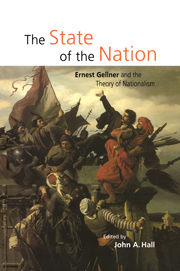Book contents
- Frontmatter
- Contents
- List of contributors
- Introduction
- Part I The making of the theory
- Part II The classical criticisms
- Part III Bringing politics back in
- Part IV Wider implications
- 10 Nationalism and civil society in central Europe: from Ruritania to the Carpathian Euroregion
- 11 From here to modernity: Ernest Gellner on nationalism and Islamic fundamentalism
- 12 Myths and misconceptions in the study of nationalism
- Bibliography of Ernest Gellner's writings on nationalism
- Index
10 - Nationalism and civil society in central Europe: from Ruritania to the Carpathian Euroregion
Published online by Cambridge University Press: 05 December 2011
- Frontmatter
- Contents
- List of contributors
- Introduction
- Part I The making of the theory
- Part II The classical criticisms
- Part III Bringing politics back in
- Part IV Wider implications
- 10 Nationalism and civil society in central Europe: from Ruritania to the Carpathian Euroregion
- 11 From here to modernity: Ernest Gellner on nationalism and Islamic fundamentalism
- 12 Myths and misconceptions in the study of nationalism
- Bibliography of Ernest Gellner's writings on nationalism
- Index
Summary
Ernest Gellner's interests embraced the whole of human history. He cooperated with archaeologists such as Paul Mellars in investigating the origins of human society; supported the work of hunter-gatherer specialists like James Woodburn, his colleague for many years at the London School of Economics; and he himself carried out extended fieldwork among tribesmen in Morocco. But I suspect that he is probably best known for his work on the transition to industrial society, and in particular, for his analysis of the links between industrialisation and nationalism. In this chapter I shall consider this powerful general theory of modernity in the context of an area that had preeminent significance in his life, if not always in his scholarly output. He spent his formative years in Czechoslovakia, in many ways the most remarkable of the ‘successor states’ to emerge after World War I. It enjoyed a real measure of democracy, and the Bohemian region had already taken significant steps towards a modern industrial society. Despite the name, it was also a country of rather more than two ethnic components: in addition to Czechs and Slovaks, there were large numbers of Ruthenians, Hungarians, Germans, Jews and Gypsies, to name only the most numerous.
The Prague where Gellner had a base in the last years of his life was the capital of a very different country. The Jews mostly vanished during World War II, as did the Gypsies.
- Type
- Chapter
- Information
- The State of the NationErnest Gellner and the Theory of Nationalism, pp. 243 - 257Publisher: Cambridge University PressPrint publication year: 1998
- 4
- Cited by

